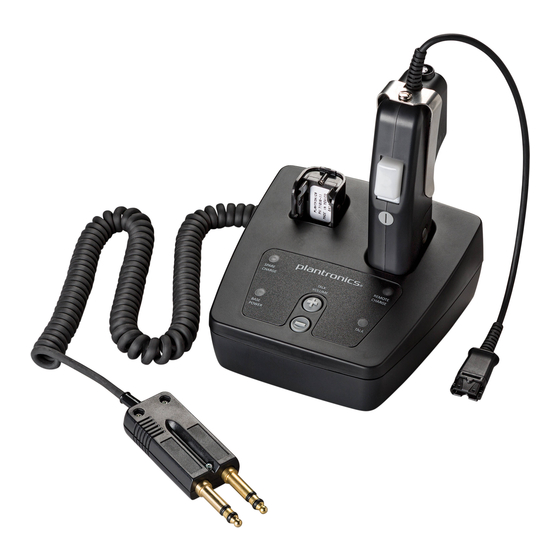
Plantronics CA12CD User Manual
Cordless push-to-talk headset adaptor
Hide thumbs
Also See for CA12CD:
- Product summary sheet (13 pages) ,
- User manual (2 pages) ,
- Declaration of conformity (1 page)
Summary of Contents for Plantronics CA12CD
- Page 1 Product Summary, CA12CD Cordless Push-to-Talk Adaptor Part No. 101987-00 Category Code: 97 Revision: C...
-
Page 2: Document Information
Specific details concerning installation and use of the CA12CD are available in the CA12CD User Guide and the Audio-Level Settings Card, both of which are available online at the Plantronics website. -
Page 3: Table Of Contents
Range and User Density Voice Privacy Frequency Hopping..............11 Encryption..................11 Subscription List of Illustrations Titles Page No. Figures: Figure 1: Model CA12CD.................5 Figure 2: Base-Unit Block Diagram ............7 Figure 3: Remote-Unit Block Diagram...........8 Revision: C CA12CD Product Summary.doc 3 of 12 pages... -
Page 4: Product Description
• Sending-sensitivity fine-adjust control • DECT™ (Digital Enhanced Cordless Telecommunications) radio operating in the UPCS band (CA12CD) for North-American applications and full DECT version (CA12CD/A and variants) for areas such as the European Union and Australia. • Compatible with most air-traffic-control and public-safety-dispatch voice switches •... -
Page 5: Functional Description
The LEDs show battery-charge status, power, and PTT status. The sending controls consist of a configuration switch to emulate Unless otherwise specified, all references to the CA12CD also apply to the CA12CD/A and its variants. Examples of H-Series headsets commonly used in air-traffic control and public-safety dispatch are the H31 StarSet®, H251 SupraPlus®, H171 DuoPro®, and H91 Encore®, along with the noise-... - Page 6 The CA12CD/A and its variants operate in the European DECT band of 1880 to 1900 MHz. The CA12CD for North America also uses DECT technology, but it operates in the Unlicensed Personal Communications Services (UPCS) 1920- to 1930-MHz band.
-
Page 7: Product Architecture
Product Architecture 2.3.1 Base Unit The block diagram of the Model CA12CD base is shown in Figure Figure 2: Base-Unit Block Diagram Revision: C CA12CD Product Summary.doc 7 of 12 pages... -
Page 8: Remote Unit
On/Off Figure 3: Remote-Unit Block Diagram Audio Performance The CA12CD audio processing is 32k ADPCM, telephony bandwidth. A wide range of audio levels can be achieved using the coarse-adjust and fine-adjust controls provided for both the transmit and the receive channels. See the User Guide and the Audio-Level Settings card (both available online) for details on optimizing these controls for the best audio performance. -
Page 9: Interference
• Repositioning the interference source, if known If the CA12CD base or remote is placed within a few inches of a cellular phone, the CA12CD may experience interference. Reposition the cellular phone or the CA12CD base or remote to increase the separation if this problem occurs. -
Page 10: Voice Privacy
CA12CD’s frequency band, or by the presence of a large number of other CA12CDs in the immediate area. Range can be maximized by taking the following steps: • Maximizing the amount of separation between the CA12CDs • Placing the CA12CDs so that they are separated by items such as cubicle walls and furniture •... -
Page 11: Frequency Hopping
Frequency Hopping The CA12CD avoids two users sharing the same channel and timeslot under normal circumstances because it chooses the best available channel, and will change channels if the channel in use experiences interference from another user. In the event of... -
Page 12: Subscription
Subscription The CA12CD remote and base are paired uniquely. The process by which the remote and the base are paired is called, “subscription.” Please see the User Guide for step-by-step instructions for subscribing a base and a remote to each other.










Need help?
Do you have a question about the CA12CD and is the answer not in the manual?
Questions and answers